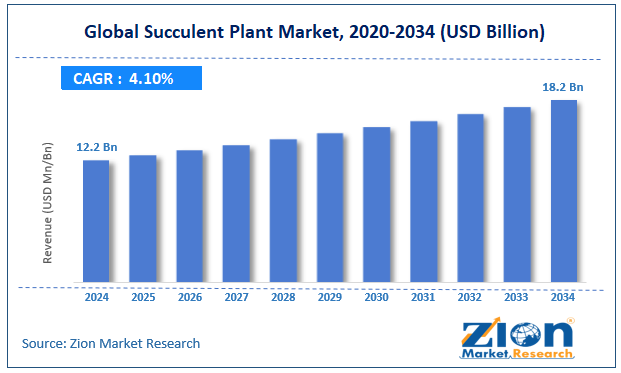Succulent Plant Market Size, Share, Analysis, Trends, Growth, Forecasts, 2034

Succulent Plant Market By Type (Aizoaceae, Cactaceae, Crassulaceae, Euphorbiaceae, Apocynaceae, and Others), By Application (Household and Commercial), and By Region - Global and Regional Industry Overview, Market Intelligence, Comprehensive Analysis, Historical Data, and Forecasts 2025 - 2034
| Market Size in 2024 | Market Forecast in 2034 | CAGR (in %) | Base Year |
|---|---|---|---|
| USD 12.2 Billion | USD 18.2 Billion | 4.1% | 2024 |
Succulent Plant Industry Prospective:
The global succulent plant market size was worth around USD 12.2 billion in 2024 and is predicted to grow to around USD 18.2 billion by 2034, with a compound annual growth rate (CAGR) of roughly 4.1% between 2025 and 2034.
Succulent Plant Market: Overview
A succulent plant has thick, fleshy layers that allow it to hold water. These plants are often found in dry or semi-arid areas, and their unique leaves, stems, or roots aid in moisture retention. The term succulent comes from sucus, which means "juice" or "sap" in Latin. Succulents in a variety of forms can hold water, including leaves and stems. A water content of 90–95% is possible for some succulent organs such as Mesembryanthemum barkleyii and Glottiphyllum semicyllindricum. Other definitions also include roots.
Hence, geophytes that survive difficult conditions by going back to their caudex subterranean storage organs may be classified as succulents.
Although these water-preserving plants are usually found in areas with high temperatures and little precipitation, such as deserts, succulents can flourish in alpine habitats on rocky or sandy soil. Succulents are designed to live in conditions with limited water supply since they can thrive on limited water sources, such as mist and dew.
Key Insights
- As per the analysis shared by our research analyst, the global succulent plant market is estimated to grow annually at a CAGR of around 4.1% over the forecast period (2025-2034).
- In terms of revenue, the global succulent plant market size was valued at around USD 12.2 billion in 2024 and is projected to reach USD 18.2 billion by 2034.
- Increasing demand for indoor gardening is expected to drive the succulent plant market over the forecast period.
- Based on the type, the Aizoaceae segment is expected to hold the largest market share over the forecast period.
- Based on the application, the household segment is expected to dominate the market expansion over the projected period.
- Based on region, the Asia Pacific is expected to dominate the market during the forecast period.
Succulent Plant Market: Growth Drivers
Increasing health benefits of succulent plants drive market growth
As more people choose indoor gardening and wellness-oriented lifestyles and succulents like aloe vera, snake plants, and jade plants help remove toxins like benzene and formaldehyde from the air, they are becoming popular for their aesthetic and therapeutic value. Unlike other plants, some succulents, such as snake plants, release oxygen at night, enhancing indoor air quality and encouraging better sleep.
By encouraging awareness, studies also demonstrate that tending to plants, including succulents, helps to lower stress, anxiety, and sadness. Having plants indoors helps one to relax and enhances one's mood. Thus, the growing health benefits of these plants are expected to flourish the succulent plant market over the forecast period.
Succulent Plant Market: Restraints
Environmental concerns and illegal harvesting hinder market growth
The succulent plant business is expanding in response to growing demand for low-maintenance, decorative plants. Still, environmental problems and illegal harvesting seriously hinder sustainable development.
Several endangered succulent species, especially those from Madagascar, Mexico, and South Africa, are being illegally harvested to meet global demand. Illegal trafficking in natural populations of protected succulents, including Dudleya, Haworthia, and other cactus species, puts these plants at risk.
Under the Convention on International Trade in Endangered Species (CITES), nations have been imposing increasingly stricter rules, including protections for delicate succulent species.
Moreover, commercial large-scale farming depends on significant land and water resources. In drought-prone places like California, water-intensive propagation methods raise environmental problems.
Succulent Plant Market: Opportunities
Growing number of nurseries offer a lucrative opportunity for market growth
The growth of the global succulent plant market is expected to increase as a result of the expansion of nurseries and horticulture. The trend of horticulture and nurseries, which made all kinds of plants available, was brought about by the rapid changes that occurred throughout the world.
The import and export of various plant types made many plants available to many consumers, and the expansion of nurseries made many varieties of decorative plants available, which can increase demand and market growth. The demand for ornamental plants is expected to be driven by the ongoing growth and preference for pot plants.
Succulent Plant Market: Challenges
Susceptibility to overwatering and improper care poses a major challenge to market expansion
Succulent plants' great sensitivity to overwatering and poor management limit the succulent plant industry since they might damage plants and discourage further purchases. Succulents kept in too frequent watering are prone to root rot since they store water in their leaves, stems, or roots.
Overwatering and soil saturation, which result from amateurs confusing succulents with common houseplants, cause most cases of succulent mortality. Bad draining in pots and containers aggravates the problem.
Furthermore, retaining too much moisture and regularly potting soil increases the risk of root damage and fungal infections. Because they absorb too much moisture, succulents are more prone to rot in non-breathable containers like glass or plastic.
Succulent Plant Market: Report Scope
| Report Attributes | Report Details |
|---|---|
| Report Name | Succulent Plant Market |
| Market Size in 2024 | USD 12.2 Billion |
| Market Forecast in 2034 | USD 18.2 Billion |
| Growth Rate | CAGR of 4.1% |
| Number of Pages | 218 |
| Key Companies Covered | The Greenhouse, Altman Plants, Qingdao Flowery Crafts Co. Ltd., AG 3 Inc, Zhejiang Wanxiang Flowers, BC Partners (Dummen Orange), Min Hui (Fujian), Horticultural Co. Ltd., Dongguan Hengxiang Artificial Plants Co. Ltd., Eurocactus, Avant Gardens, Qingdao Brilliant East International, AdeniumRose Company, Peace Tree Farm, Costa Farms, OVATA, Yiwu Lishi, and others. |
| Segments Covered | By Type, By Application, and By Region |
| Regions Covered | North America, Europe, Asia Pacific (APAC), Latin America, Middle East, and Africa (MEA) |
| Base Year | 2024 |
| Historical Year | 2019 to 2023 |
| Forecast Year | 2025 - 2034 |
| Customization Scope | Avail customized purchase options to meet your exact research needs. Request For Customization |
Succulent Plant Market: Segmentation
The global succulent plant industry is segmented based on type, application, and region.
Based on the type, the global succulent plant market is bifurcated into aizoaceae, cactaceae, crassulaceae, euphorbiaceae, apocynaceae, and others. The Aizoaceae segment is expected to hold the largest market share over the forecast period. Succulents in the Aizoaceae family, including those in the Lithops genus, are valued for their vivid blooms and distinctive, stone-like look. Their market demand is increased by their unique appearance, which makes them quite desirable for both interior and outdoor decorative applications.
Additionally, these succulents need less watering and maintenance because they are suited to dry climates. Their hardiness and ease of care are in line with consumers' increasing desire for eco-friendly and low-maintenance plants, particularly among city people who are time- and space-constrained.
Based on the application, the global succulent plant industry is bifurcated into household and commercial. The household segment is expected to dominate the market expansion over the projected period. Compact, low-maintenance plants like succulents are becoming more popular as living areas get smaller and more urbanized. Succulents are preferred by households due to their low maintenance needs, aesthetic appeal, and air-purifying properties.
Succulents are also frequently used for DIY terrariums, table centerpieces, and interior décor. Certain succulents, like aloe vera and jade plants, are recommended by Feng Shui and Vastu Shastra to draw wealth and good vibes. Thus driving the industry growth.
Succulent Plant Market: Regional Analysis
Asia Pacific dominates the market over the projected period
The Asia Pacific is expected to dominate the global succulent plant market. The rise in floriculture and horticulture is the cause of the regional expansion. The area can support the growth of a variety of flowers and decorative plants, which could raise demand for them.
Additionally, people are more concerned with interior design and the growing number of weddings where flowers and plants are regarded as lucky charms. It is anticipated that floriculture growth will promote the growth of decorative plants.
Succulent Plant Market: Competitive Analysis
The global succulent plant market is dominated by players like:
- The Greenhouse
- Altman Plants
- Qingdao Flowery Crafts Co. Ltd.
- AG 3 Inc
- Zhejiang Wanxiang Flowers
- BC Partners (Dummen Orange)
- Min Hui (Fujian)
- Horticultural Co. Ltd.
- Dongguan Hengxiang Artificial Plants Co. Ltd.
- Eurocactus
- Avant Gardens
- Qingdao Brilliant East International
- AdeniumRose Company
- Peace Tree Farm
- Costa Farms
- OVATA
- Yiwu Lishi
The global succulent plant market is segmented as follows:
By Type
- Aizoaceae
- Cactaceae
- Crassulaceae
- Euphorbiaceae
- Apocynaceae
- Others
By Application
- Household
- Commercial
By Region
- North America
- The U.S.
- Canada
- Europe
- France
- The UK
- Spain
- Germany
- Italy
- Rest of Europe
- Asia Pacific
- China
- Japan
- India
- South Korea
- Southeast Asia
- Rest of Asia Pacific
- Latin America
- Brazil
- Mexico
- Rest of Latin America
- Middle East & Africa
- GCC
- South Africa
- Rest of Middle East & Africa
Table Of Content
Methodology
FrequentlyAsked Questions
A succulent plant has thick, fleshy layers that allow it to hold water. These plants are often found in dry or semi-arid areas, and their unique leaves, stems, or roots aid in moisture retention.
The succulent plant market is driven by several factors, such as the rising popularity of indoor plants, the growing disposable income, increasing adoption of gifting and events, increasing health and wellness trends, and others.
According to the report, the global succulent plant industry market size was worth around USD 12.2 billion in 2024 and is predicted to grow to around USD 18.2 billion by 2034.
The global succulent plant market is expected to grow at a CAGR of 4.1% during the forecast period.
The global succulent plant industry market growth is expected to be driven by the Asia Pacific. It is currently the world’s highest revenue-generating market due to the high disposable income and growing urbanization.
The global succulent plant market is dominated by players like The Greenhouse, Altman Plants, Qingdao Flowery Crafts Co., Ltd., AG 3 Inc, Zhejiang Wanxiang Flowers, BC Partners (Dummen Orange), Min Hui (Fujian), Horticultural Co., Ltd., Dongguan Hengxiang Artificial Plants Co., Ltd., Eurocactus, Avant Gardens, Qingdao Brilliant East International, AdeniumRose Company, Peace Tree Farm, Costa Farms, OVATA, and Yiwu Lishi, among others.
The succulent plant industry market report covers the geographical market along with a comprehensive competitive landscape analysis. It also includes cash flow analysis, profit ratio analysis, market basket analysis, market attractiveness analysis, sentiment analysis, PESTLE analysis, trend analysis, SWOT analysis, trade area analysis, demand & supply analysis, Porter’s five forces analysis, and value chain analysis.
HappyClients
Zion Market Research
Tel: +1 (302) 444-0166
USA/Canada Toll Free No.+1 (855) 465-4651
3rd Floor,
Mrunal Paradise, Opp Maharaja Hotel,
Pimple Gurav, Pune 411061,
Maharashtra, India
Phone No +91 7768 006 007, +91 7768 006 008
US OFFICE NO +1 (302) 444-0166
US/CAN TOLL FREE +1 (855) 465-4651
Email: sales@zionmarketresearch.com
We have secured system to process your transaction.
Our support available to help you 24 hours a day, five days a week.
Monday - Friday: 9AM - 6PM
Saturday - Sunday: Closed






